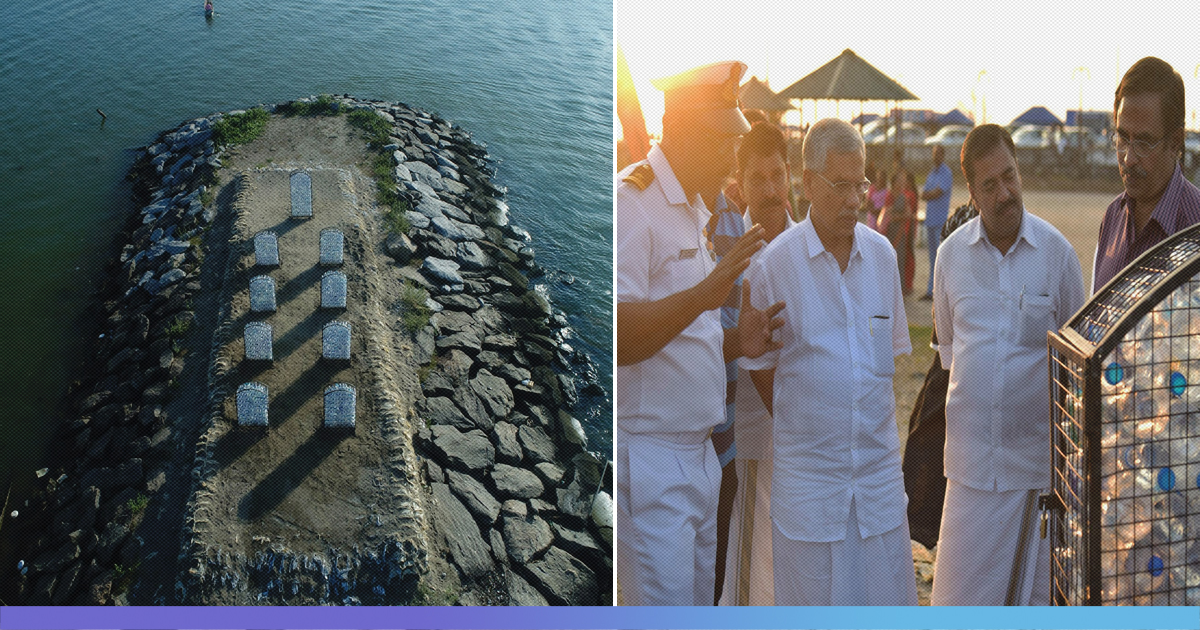
Kerala: World’s First Marine Cemetery In Memory Of 9 Critically Endangered Species In Kozhikode
13 Dec 2019 9:30 AM GMT
Editor : Reethu Ravi
Reethu, a story teller, a person often found between the pages of a book or contemplating the nuances of life.
At the meeting point of Chaliyar river and Beypore Beach in Kozhikode, stands a cemetery in the memory of eight critically endangered marine species and one freshwater fish – Miss Kerala(Sahyadria denisonii).
The cemetery is a grim reminder of the ecological destruction caused by climate change and water pollution. Inaugurated on December 4, on World Wildlife Conservation Day, the cemetery set up by Jellyfish Watersports, Kozhikode and Climate activist Aakash Ranison aims to spread awareness about the drastic effects of single-use plastic on marine life.

“The logic was very simple. It’s next to the sea, and it’s in Kerala, so we wanted to do something that would connect to the people, and people could feel for. What connects people here is the fish; because everyone is dependent on fish here,” says Ranison, while speaking to The Logical Indian.
S. Sambasiva Rao, District Collector of Kozhikode, and V.K.C Mammed Koya, MLA, Beypore inaugurated the cemetery and held a memorial service for ‘Miss Kerala’ to sensitize people about the issue of marine pollution. The Collector also asked everyone present to pledge to give up one single-use plastic.
“The Marine Cemetery is a reminder of the destruction that we are bringing upon our planet in the name of convenience. So, we are supporting and promoting this initiative as part of Clean Beach Mission to spread awareness, as it not only educates locals and the world about the effects of single-use plastic, but it will also help Kozhikode become a sustainable travel destination,” Rao was quoted in a press release.
The Marine Cemetery
The marine cemetery consists of nine gravestones with a tombstone made of iron frame and body made of single-use plastic bottles. Eight of the tombstones feature critically endangered marine species while the biggest tombstone feature Miss Kerala – a freshwater fish endemic to the fast-flowing hill streams and rivers of the Western Ghats (including Chaliyar river).

“Miss Kerala is a very beautiful ornamental fish that had been overexploited, over exported, overfished and because of pollution, is now in the IUCN red list – which is endangered. We hoped that people would connect more to it,” says Tarun Gupta, Brand Strategist, Jellyfish Watersports.
Recognising that marine pollution is a problem concerning the entire world, they made a portable design of the marine cemetery to be able to install it anywhere in the country. It will be on display at the beach for the next six months.
Plastic Bottles For The Art Installation
“It’s just one bottle, said 7.7 billion (People),” says Ranison, highlighting the problem of single-use plastic in the country.
For the last six years, Jellyfish Watersports has been involved with spreading awareness about plastic pollution through recreational water activities. Three months ago, the organisation teamed up with Aakash Ranison to organise a Kayaking expedition to collect garbage in the Chaliyar river. Over 100 people paddled 68 km stretch to clean the river.

The team then conducted a beach clean up drive in Beypore beach, Kozhikode in November. The plastic bottles collected from both the events were then used to make the marine cemetery.
“We did a beach cleanup in November, where around 80 people turned up. In four hours, we collected about 800 Kg of solid waste. Whatever plastic bottles we collected, we kept it aside. Rest of the solid waste we gave to Municipality. We decided to make the art installation of the marine cemetery using the 2000 plastic bottles that we had collected,” says Ranison, who has been a regular part of clean up drives across the country.

Why A Cemetery?
The team had asked the volunteers of the kayaking expedition and cleanup drive to come up with ideas to use the plastic bottles they had collected. They also ran a small campaign – ‘shape the scrap’ for the same.
“After several discussions, we realised that, usually, after the art installations are installed, people come, take selfies and then go away. It restricts to that; there is no discussion happening. So, we were very clear that we did not want to give people a good looking object. Rather, we wanted to create something that would cause a little discomfort for them,” explains Gupta.

“Cemetery is unpleasant to see. We wanted people to ask us why cemetery – because your plastic bottle is leading to the death of marine species,” adds Gupta.
Ranison also believes that fear can drive people to act. “I think that a lot of things we follow are related to fear. It’s the thought process that people are carrying in their mind. At this point, we have to play with the brain of other people and communicate in the language they understand. They don’t understand the language of problem-solving or that of safeguarding our nature. The only language, as of now, they can understand is fear,” he says.
People’s Reaction
“We didn’t think that it will affect people in this way. When we were making it, we didn’t bother about it – once we put it out there, how will it impact people. But the kind of response we have got – from the local area, from national and international media – is overwhelming,” says Ranison.
Due to the overwhelming response, the team is planning to take the installation to various cities across the country. They have got requests from Kochi, Kerala to display it there.
“The Kozhikode District Administration’s Clean Beach Mission, Beypore Port Department, and officers from Beypore Coast Guard have been very supportive to us. The District Administration has also been very kind to us to provide a space, understand the idea and support us,” says Gupta.
Also Read: Five Vizag Divers Remove Nearly 5000 Kg Of Plastic Waste From Sea In 13 Days
 All section
All section













